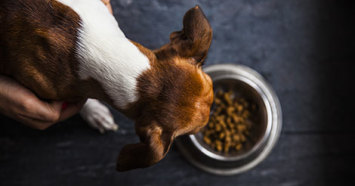
Among the many decisions we pet owners have to make is how (or, more accurately, when) we want to feed our pets. It never really seemed like a big deal to me, frankly. My childhood dog, Sophie (a unique-looking Doberman-Airedale mix), had full, constant access to her giant bowl of food with no issues.
This method of feeding is known as free feeding. As it turns out, the free versus scheduled feeding debate is a hot one. A lot of people - owners, vets, trainers, behaviorists, scientists - have very strong opinions about which is the right way to go. I honestly don’t have a one-size-fits-all conclusion to share; I think it’s important to think through the pros and cons of each method to figure out what works for your pet(s).
Free Feeding - Pros
Pets can eat as much as they need; they are never left feeling famished between meals.
They never have to miss a meal if you’re running late; you don’t have to worry if you can’t get home right at feeding time.
There are less food-guarding issues - because they always have access to food and don’t have to worry about when their next meal is coming, it takes the value away from the food.
Good for active pets (or pets that have varied levels of activity) because if your pet needs to eat more calories on a certain day to account for extra calories burned, he can.
Some studies have shown cats in particular eat best like this (but, of course, there are also some that contradict that). It's important to note that cats after spaying may experience changes in metabolism and appetite, which can lead to weight gain if not properly managed. Adjusting portion sizes and maintaining a consistent feeding schedule can help mitigate these effects and keep your cat at a healthy weight.
Free Feeding - Cons
The number one con with free feeding is that it puts a lot of pets at risk for over-eating and obesity.
It can be hard to do in multiple pet households (especially if they are on different food).
Because the pet eats throughout the day, it can cause difficulty with potty training (you can’t anticipate their need for trips outside as easily as you can with a scheduled meal time).
Depending on the environment and your set up, food left out can sometimes promote an unhygienic situation.
Tip: Keep bowl in area you can see to observe how much your pets eat.

Scheduled Meals - Pros
You can control the portions easily.
It gives your pet structure to his day, and in the home hierarchy (he knows you are the giver of food).
It helps with potty training, as you have a good sense of when he will need to go outside after a meal.
It helps keeps things clean (both in the sense that you don’t have food sitting out, and visually, since you can put the bowls out of sight between meals).
It helps you more easily notice when your pet’s appetite makes a sudden shift (thereby alerting you to a possible sickness early).
Scheduled Meals - Cons
You have to be home to feed your pet (although, there are automatic feeders on the market you can get to address this).
It might encourage your pet to gulp or wolf down his food since he anticipates it so greatly.
It might lead to food-guarding--if he only gets access to food for a little while twice a day, those times can possibly become very high-value and high-stress.
I’m not pushing you one way or another, but you might find that, after reading this, you’d like to switch your style. Here are a few tips to make it an easy transition:
Moving from Scheduled to Free Feeding
If you want to switch from scheduled to free feeding, there are a couple ways you could do it (consult your vet if you have any concerns):
The first approach is to fill up the bowl with as much as it will hold. Let your pet eat his fill, even if it’s a really big amount. Fill up the bowl whenever it gets empty. In a day or two, your pet will begin to understand the new approach and his body and appetite will probably even out (although it might not, so do pay attention). If it doesn’t even out, free-feeding may not be for him.
A second approach is to fill up the bowl with a pre-measured amount. Once your pet walks away from the bowl, refill it with the same amount. And again, it might take your pet a few days to understand what’s happening, but he should even out.
Moving from Free to Scheduled Feeding
If you want to move from free feeding to scheduled feeding:
Look up the appropriate daily amount to feed your pet (either on the packaging or on the company’s website)
Divide this amount by two. Offer one portion in the morning and one in the evening.
When it’s mealtime, keep the food bowl down for 15-20 minutes. If your pet is no longer eating (or never started), take the bowl up.
Note: If he doesn’t eat, don’t panic; it will take him a few meals to figure out what’s happening.
Resist the urge to double the portion or add stuff into the bowl (like gravy) at the next meal. It’s important not to teach him that if he holds out long enough, he’ll get special treats. Don’t coddle him; he will not starve. Keep offering meals twice a day, and he will eventually eat when he’s hungry enough.